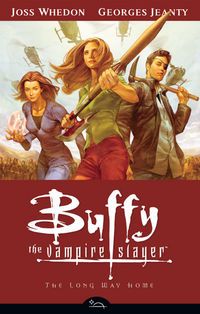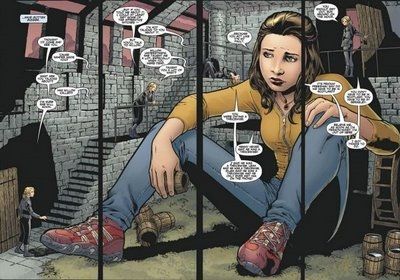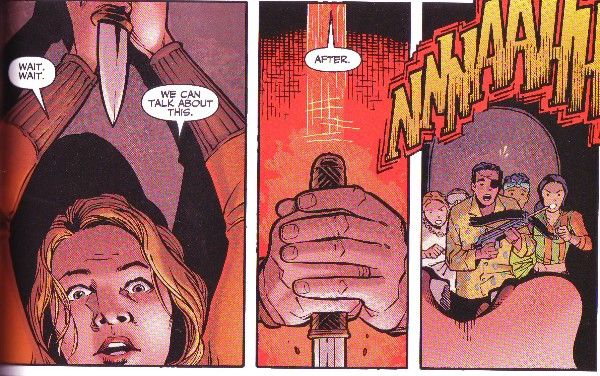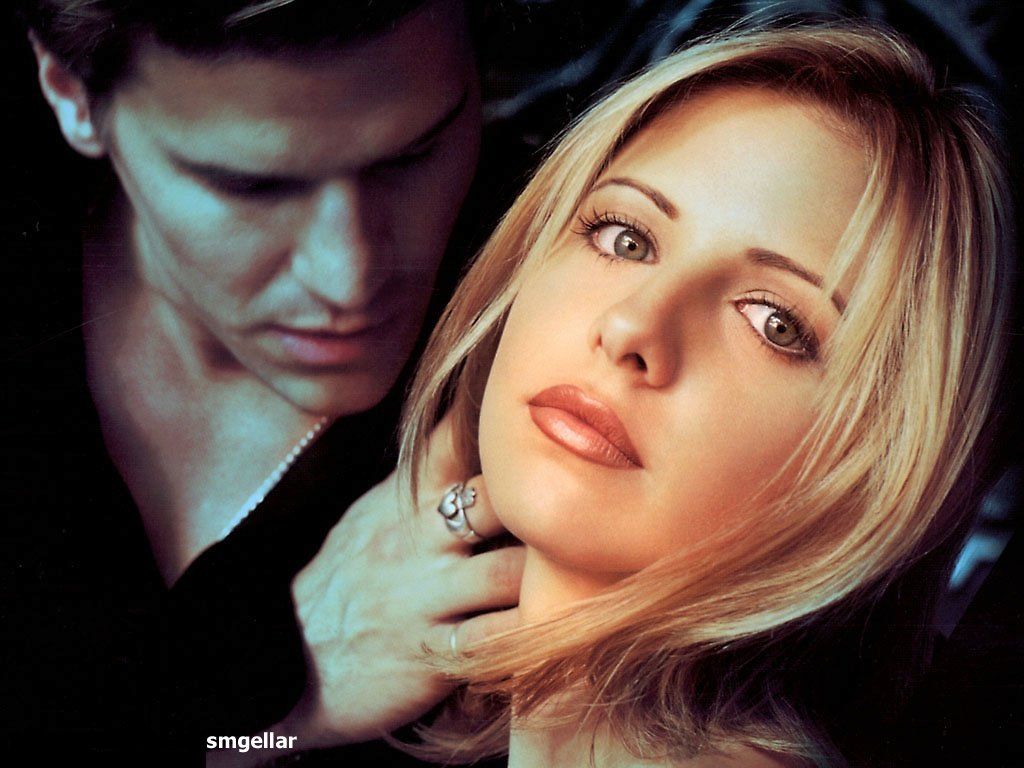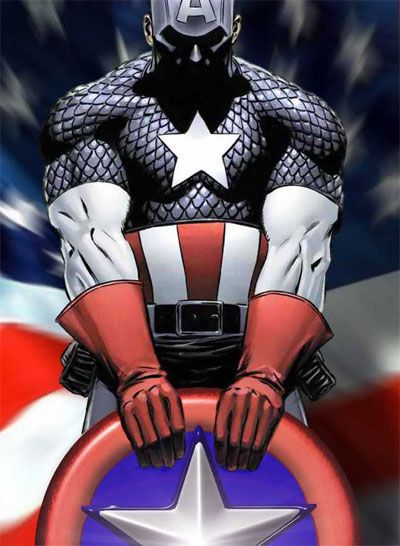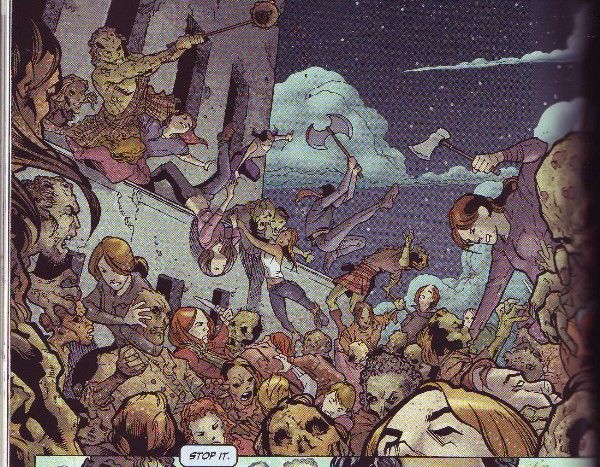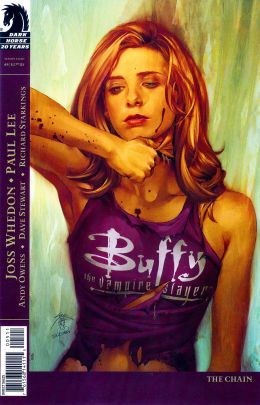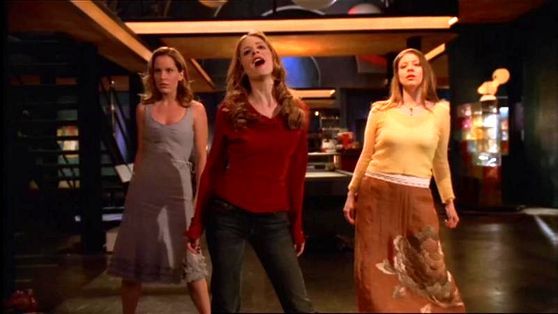And on top of all that, is there anyone out there who can say with a straight face that Buffy the comic is equal to Buffy the TV show? That they are equivalent storytelling experiences? Buffy season 8, the comic, works mostly because it's the only game in town for an audience that's starved for it. If the story was being televised, fans would be screaming bloody murder about how it's not a patch on seasons 2 and 3.
- Greg Hatcher
Short review of the first Buffy: Season Eight trade.
It's competent.
Longer review:
There's been a decent number of Buffy comics over the years. Some of 'em, specifically the historically centered Tales of the Vampires and Tales of the Slayers were quite good. Despite the fact that Buffy herself didn't show up much. The rest... Well, to be honest I read most of 'em and don't remember a damn thing. So I'm 'a going with "forgettable."
But despite the lopsided quality to crap ration in previous Buffy comics, I had high hopes for THIS particular version, dubbed "Season Eight," implying that these comics are supposed to BE the eighth season of the TV show, which was canceled after seven year-long seasons.
Second, these issues- although NOT the ones that followed them - were written by the guy who created, oversaw, and wrote/directed most of the best episodes of the TV show, Joss Whedon. Even more reassuring: Whedon had prior comic experience - He wrote for both Tales of the Slayers and Vampires and he's currently scriptin' Marvel's Astonishing X-Men.
So I walk in with fairly high expectations, and end up with "competent."
Bummer.
Still, y'know... Competent IS competent. The plot development, character development bits and story beats are effectively done, and the pacing is solid. I didn't find any glaring writing flaws.
Likewise, primary artist Georges Jeanty turns in a solid-but-unspectacular performance. His stuff is surpsingly cartoony for a comic adaptation of a TV show, but it does, generally, capture the likenesses of the actors.
which is what licensed TV based art is supposed to do, right?
He's neither a briliant draftsman nor a spectacular storyteller. But, again. Competent.
And, in some ways, Competent Plus. Jeanty has a genuine gift for using the
"camera" to frame his shots - Unless this comes from Whedon's "directing."
There were a coupe times when these two showed off a damn-near-Eisnerian sense of creative exploration. Check out this sequence, where Buffy talks to her sister-the-giant. (Ummm... Spoilers.)
Or this spectacular panel to panel transition fake-out, where a squad of Buffy's buds find an evil witch threatening Buffy with a knife.
So on the plus side, we have general competence mixed with a handful of moments of genuine artistry.
On the downside... This ain't a patch on season two.
*End of Teaser - Cue Theme and Opening Titles*
One of the commentators in our last Buffy post said he'd never watched the show.
So.
Some background.
The Buffy the Vampire Slayer TV show is (A) surprisingly close to what you'd figure it would be about from the title. And (B) my favorite TV program ever.
It's MOSTLY rooted in horror, but Buffy displays a cheerfully Catholic approach to genres, pulling from situation comedy, noir-ish detective stories, soap opera, musicals, and (as we'll see) superhero comics.
The plot has Buffy - a head cheerleader/prom queen type - finding herself granted superpowers and recruited to be a kind of supernatural sheriff for the town of Sunnydale, which is beset by a steady stream of Vampires. And Ghosts. And Frankenstein's monster-esque cyborgs, giant insects employed as substitute teachers, four inch tall fear demons, sex poltergeists, and evil robots that want to marry Buffy's mom. Seven years/seasons worth of monster-of-the week.
But we are a comics blog here, so I'd like to swing back to comics. Because it's the comic-stuff that makes the show good. So let's play some compare and contrast. Starting with the most obvious similarity:
Our hero is a super-powered girl with a secret identity defending the status quo from super-powered antagonists. Just like Superman, Daredevil, Impulse, the Red Raven or the Green Lama. As her career progresses, Buffy even joins up with a bunch of other "powered" types - albeit powered types based on horror tropes, including a witch, a werewolf, and a couple of Vampires - and ends up heading up a veritable Justice League of Ghost(etc.) busters.
Secondly: I just finished reading the DC Comics Guide to Writing Comics. And damned if it couldn't double as The TV Writers Guide to Writing Buffy the Vampire Slayer. The basic structure of Buffy has one main, three act plot per episode, but two or three sub-plots spanning multiple episodes happening in the background. These either comprise individual character arcs, foreshadow upcoming events, or contribute to the main story of the season, which generally concludes with the defeat of the "Big Bad" circa the last episode before summer reruns.
Many, hell, most current superhero comics feature a similar approach to story construction - There's the current story, there's at least one long-term story, and there's smaller character stories mixed in. Now I dunno enough about TV to know if Buffy's structure is common to most dramatic TV shows, or if it was nicked from comics. But it's pretty clear SOMEONE'S copying SOMEONE here.
(P.S. Anybody know? Did the Buffy/X-men sub-plots and main plot structure originate in TV or comics?)
*****ticky marks******
Third, and most importantly: Like much fiction,Buffy and the spandex set are both rooted in metaphor, and they both apply metaphor in similar, if not precisely the same ways.
They both make major use of recognition and inspiration metaphors. Which, in the midst of the conversation where all this was hashed out, got shorthanded to "IN" and "OUT" metaphors, respectively. This gets a little complicated, so we'll hit them one at a time.
First, the "IN" or recognition metaphors: See, superhero comics and 100 pound prom queens who fight killer cyborgs are both, y'know, at their core.... pretty silly.
Yeah, I know. And water's wet, right? And the sun might show an occasional propensity towards hotness.
But work with me. I'm going somewhere.
In superhero books, metaphor can be used to bridge the larger-than-life and the true to life, and make the big scale theatrics relatable to the audience. Take Rogue of the X-men, ferinstance. Her powers (she drains life by touching folks) are pretty far out there in terms of believability... But in metaphorical terms, viewed as a fear of human contact, of getting to close to other people, they make perfect sense. Or take the X-men as a concept.
Recently, there was much bitching about the X-men in our forum. The gist of the argument being "Why are the X-men feared and hated while the Avengers and the Fantastic Four get a free pass? They're all superheroes, and none of 'em CHOSE their powers."
Now I see the logical argument, but fiction is about more than logic. On a thematic level, well, the X-men and the Avengers are different comics about different stuff, so their fictional realities are arranged so as to emphasize these different themes.
The central concept of the X-men deals with the relationship between outcasts (or just plain people-who-are-different) and society. Sometimes society responds with fear, mistrust, even hatred. The central metaphor of the Avengers is... Well, I'm not sure. But, again. Different books. Different themes. Different "INs."
The metaphorical "IN" in Buffy the Vampire Slayer is similar. But different. Similar in that it looks at true to life situations, different in that Buffy is a horror show first and foremost, so the metaphors tend to have a darker texture to 'em. Steroid-type drug abuse turns the swim team into Monsters. (And they eat people.) A girl feels ignored, so she turns invisible. (And starts trying to kill people.) Buffy sleeps with the wrong guy (in this case a vampire) he turns evil and... well, you know the drill. Still, like Rogue, this is recognizable behavior dressed like the fantastic.
One more difference. In the Buffy-verse, text and subtext tend to bump into each other an' rub together. Metaphor is streamlined into the nature of Buffy's reality. The town where Buffy lives has the "super power" to bestow metaphorical properties on it's inhabitants, and, unlike Rogue or the other X-men, the characters seem to be slightly aware of this.
So that's the "IN" part. Let's head "OUT," and look at inspiration metaphors.
Here, we're dealing with higher ideals. Superman: Truth, Justice, and the American Way. Or Green Lantern: Magic jewelry that creates giant boxing gloves and evil pink aliens. This might be tough for the average fan to relate to until We think about how much of a difference one person can make in the world through applied force of will.
There's a lot of OUT in Buffy, but it works in a couple different ways. Buffy and her pals are less easily described as "paragons of virtue" than yer average superhero. Buffy's best friend turned into an evil witch and tried to destroy the world as a big example, and on a smaller scale Buffy's more prone to self doubt and destructive behavior than your average super-type. But the Justice League of Buffy and her Buds still have a buncha noble traits: They look out for the innocent, adhere to duty, (but not blindly) and demonstrate a sense of humor under pressure - These are noble, admirable traits.
But agan, Buffy is a HORROR show. Which means the OUT metaphors work in reverse, too. If you engage in laudable behavior, you become a hero, like Buffy or Xander. If you engage in bad behavior, you get killed by a mummy. So the IN and OUT metaphors are a little confused, here.
As Buffy progressed through the seasons it did move away from both the IN and OUT metaphors and developed into a more character based,
soap-opera-ish show. Not to it's benefit, in my mind: There's a reason Greg Hatcher in the quote waaaaaay at the beginning says "Seasons Two and Three" and not "Seasons six and seven." But it always remained a fairly thoughful show and, kinda like the Georges Jeanty panels up-top, had a streak of formal experimentation. There was a musical, there was an almost all silent episode, there was a symbolic dream episode with no formal plot - The creators were obviously thinking about expanding the scope of what you can do with TV as a medium.
****Ticky marks****
Basically, Buffy always felt like it was assembled by restless English Majors who big fans of good superhero comics.
Which pretty much explains why it's my favorite show of all time.
Which brings us (finally!) back to Long Way Home. It stops being like GOOD superhero comics, and instead it starts to feel like BAD superhero comics, of the overly nostalgic variety. It seems just as concerned with recycling past glories than creating new ones.
I see why Whedon's doing this, mind. The projected audience for this comic are pre-indoctrinated hard core fans of the TV show. So the introduction of familiar villains and settings helps comfort and acclimate the boob tube-to-comic converts to a new medium.
Which is ODD, because the plot has definitely advanced in the down-time between the end of season seven and the start of season eight. The last season of the TV show had Buffy training a gaggle of brand new slayers. and Season Eight takes this to a whole different level: Buffy's been promoted to general-and-dictator-for-life of a small army of young superhuman gals with the same super strength, toughness, and enhanced senses package that Buffy herself received. Strangely, (or not, considering that Whedon is writing an X-men book) this ends up feeling a bit like Grant Morrison's take on the X-men. Buffy and her pals are teachers. Their charges, heroes in training.
It's sad, then, that the target audience is folks that are intimately familiar with the show. Especially since (A) in it's original format, the first storyline was composed of four individual comic issues. Which means that the first, second, and third issue ended with a cliffhanger.. And in fact, in EVERY case the cliffhanger-that-ends-an-issue was the reappearance of a familiar character from the TV show.
This "Hey! Look! A familiar character!" ending isn't RARE in comics, but it always annoys me. It might appeal to those folks who are already immersed in the fictional world being presented, but it won't get newbies back for the next issue. And, more'n that, it simply feels lazy... In stead of working to define characters and make the audience relate to them, the writer is coasting on previous audience goodwill, instead of working to EARN the audience admiration.
And, honestly, I have a pretty dim view of fans who say I MUST come back for the next issue... Because... um... I recognize a character."
And we ain't even talking MAIN characters in two of the three instances. The first issue, ferinstance, concludes with the reappearance of Amy the Witch, who popped up in only a handful of episodes. (Not counting those couple years where she was turned into a rat.)
Worse still, she was a Season SIX villain. Season Eight isn't even reliving the show's glory days... It's obsessed with it's death throes.
There is, I suppose, an upside to this excess of familiarity: The comic does succeeds in many of the ways the TV show did. It briskly switches from funny mode to scary mode on a dime, and there's some great cutesy dialog. Which is a plus if you like cutesy dialog.
"My love." He called me "My love". And then I threw up in my mouth a little.
The thing about changing the world... Once you do it, the world's all different.
One Slayer fighting alone is formidable. Two is formidabler. Or... three? Mega-formidable. And after mega, it goes to mondo, then super, hyper, beaucoup d'crazy, stupid... it gets *exponentially* prefixy.
If not, well, you're probably not a fan anyway.
And there's some improvements as well. You can do BIG better (and much cheaper) in comicsthan TV, which means we end up with scenes like this
Which you can't do on TV without breaking the bank. So I didn't hate it, but I wouldn't recommend it, either.
So. Not recommen.. But, hey. I forgot about the last story in the collection.
The last one is... something else altogether.
Call it Fake Buffy in Fairyland.
This story, which occupied only a single issue of the comic, was much less familiar. And to tell you the truth I'm still processing it. If it's designed to kick audiences out of their first-four-issue comfort zone, well, if I'm a representative sample, it worked.
The general plot has one of the Slayer girls hired to "be" Buffy - To kind of borrow her identity to deflect some of the heat off the real Buffy, in case her enemies try to kill her.
The Chain has "Fake Buffy" (actually one of the fake Buffys, as it turns out) fighting a war in a vaguely Norse underground fairyland and... not winning. There's all sorts of themey metaphory stuff here, which I haven't QUITE sorted out: Duty, identity, the importance of the individual in the scope of history all show up.
Aaaaand There are also some fairly major pacing and cutting problems: 22 issues of a comic book simply don't equal 44 minutes of a TV show, and this issue NEEDS more room to believe and develop.
Still, it demonstrates the same kind of restless experimentation that brought us Buffy: the Musical.
And, yes, that's a good thing.
So Not Recommended, but I AM curious as to where the series is going next.


